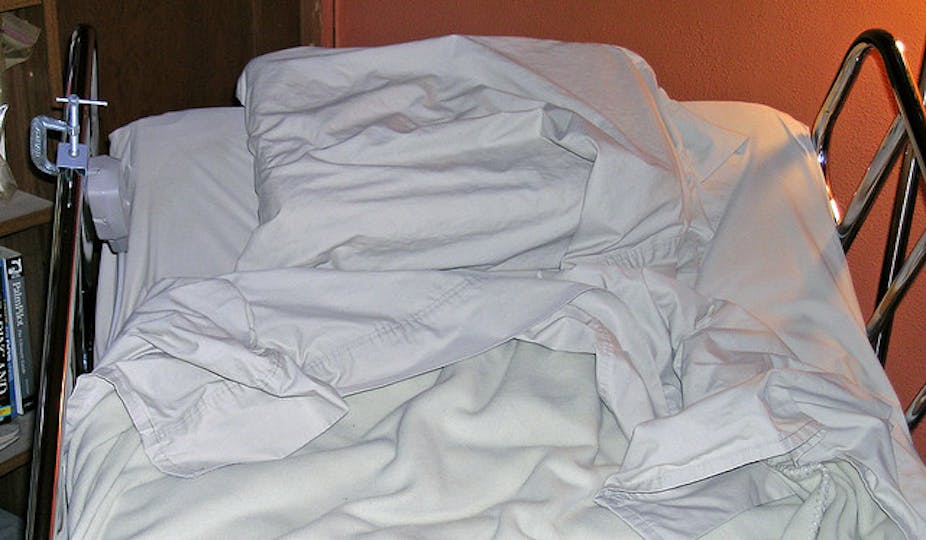According to a recent report in the Canberra Times, Thomas Barry Moore, a former air force serviceman, has been in a persistent vegetative in a Chinese hospital for 118 days. He suffered a stroke on December 31 in Zhengzhou in north-central China.
One of the most disturbing features of this case is what his daughter was told when she asked the treating doctors to withdraw Thomas Moore’s life support.
Despite her father being in persistent vegetative state, she was informed that “ethical concerns” prevented them from removing him from life support.
Now, Ms Woolley is sending the hospital $770 a week to keep her father “alive.”
Law at the end of life makes it clear that when treatment is “futile”, that is, offers no reasonable prospect of return to a meaningful quality of life, it may be withdrawn.
Not to do so breaches human rights obligations against cruel and unusual treatment. Nonetheless, examples continue to proliferate revealing how this law is not applied properly.
Sometimes the problem concerns the ethical perspective that life should be preserved at all cost. Such arguments are understandable and persistent.
More concerning is when an appearance of financial conflict of interest complicates such matters.
An instructive example of this happening in Australia concerns the case of Ms DL. DL was involved in a high speed motor vehicle accident on 30 December 1999, which caused a severe head injury.
She was unresponsive at the scene, was stabilised at Gold Coast Hospital and transferred to Princess Alexandra Hospital where a CT Scan revealed significant skull fractures, brain swelling and subarachnoid blood.
On discharge from the Princess Alexandra Hospital Intensive Care Unit on 6 Jan 1999, she was only able to move when stimulated, was not obeying intructions and required tube feeding.
Her condition did not improve - it only got worse.
A letter dated 13 July 2000 from Dr Jeff Webster, neurosurgery registrar at the Gold Coast Hospital shows that, on that date, D required a trachestomy for breathing and as well as the nasogastric tube, an indwelling urinary catheter.
She had severe contractures of her arms and legs and a communicating hydrocephalus (water on the brain) requiring a shunt.
She had been rejected by the Brain Injury Rehabilitation Unit and Slow Stream Rehabilitation Unit at the Prince Charles Hospital due to the opinion of clinicians there that their treatments would offer D “no reasonable benefit.”
This was an important early finding relevant to “futility” of treatment. A letter from Dr Andrew Wignall of Royal North Shore Hospital, dated 21 October 2005, indicates D’s condition was even worse by then.
She was experiencing copious saliva and coughing spasms.
He confirmed the patient was in a persistent vegetative state (PVS). This view has subsequently been reinforced by other consultants and ethicists familiar with such decisions, who reviewed the relevant documents.
D was 15 years old at the time of the car accident. Her mother doubts she had ever thought of death and so no form of advance directive was made or consideration of substituted judgment is possible.
All of D’s family want treatment withdrawn because they feel her life has not been meaningful in any rational sense since the accident.
And, there is no reasonable prospect it will become meaningful. D’s grandmother is a retired senior nursing sister with a good understanding PVS and withdrawal of treatment.
D’s contractures could well be painful. Her excess saliva is likely to lead to the sensation of drowning unless regularly suctioned.
She is at high risk of bed sores, infections and (on statistical evidence) sexual and physical abuse if her institutional care continues indefinitely.
In 2004, the Guardianship Tribunal made an order pursuant to the Guardianship Act 1987 (NSW) concerning Ms DL.
It ruled that her guardian be the Public Guardian, not her mother who wanted treatment withdrawn.
On 12 January, 2009, the NSW Office of Public Guardian wrote to Dr Clayton King a consultant at the Brain Injury Unit of the Royal Rehabilitation Centre in Sydney, asking him to respond to D’s mother’s claims that D’s treatment was technically “futile” and should be discontinued.
It is rare to see an instance of an intensive care physician in an Australian public hospital opposing relatives who wish treatment declared “futile”, but this appears to have happened in the case of DL.
According to D’s mother, Karen, the Brain Injury Unit of the Royal Rehabilitation Centre Sydney apparently continues to charge Suncorp Metway, the Queensland accident compensation authority, for reports about D.
If so - or if in any other way such an institute benefits financially from continuing life support of D - this leads to a potential financial conflict of interest for professionals at the institution continuing to assess her best interests.
Until recently, there has been little judicial discussion in Australia about the role of judicial bodies in protracted futility disputes between clinicians, administrative bodies and relatives.
The important issue of potential financial conflict of interest in this context has not much been raised.
Clinical ethics committees with a range of liability-protected health professionals, community and legal expertise are well positioned to assist the burden of professional responsibility in such cases.
If such matters cannot be readily resolved in Australia, what prospect do the relatives of Thomas Moore have for preventing them from being charged large weekly sums for “treatment” that neither they nor he would want?
Perhaps we need some agreed guidelines on how to standardise governance of such matters not just nationally but internationally.

